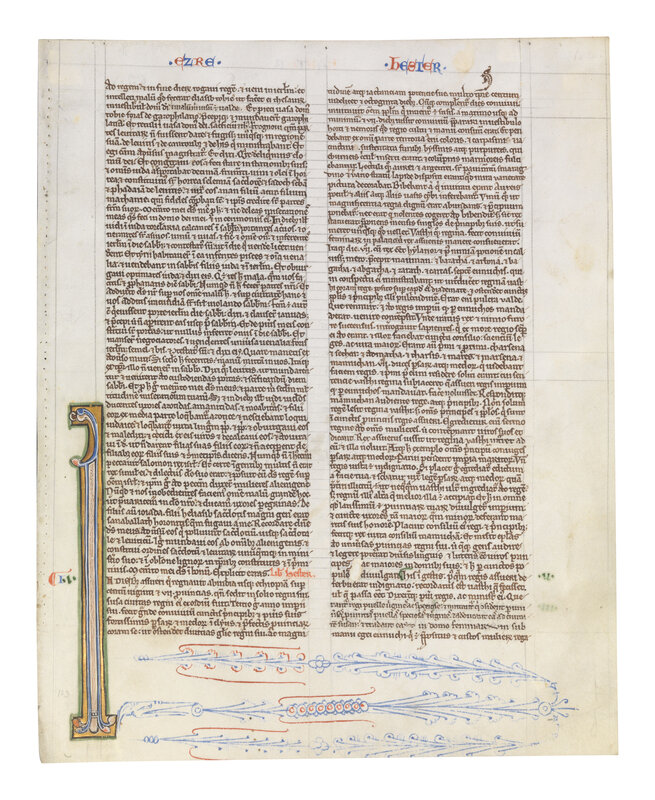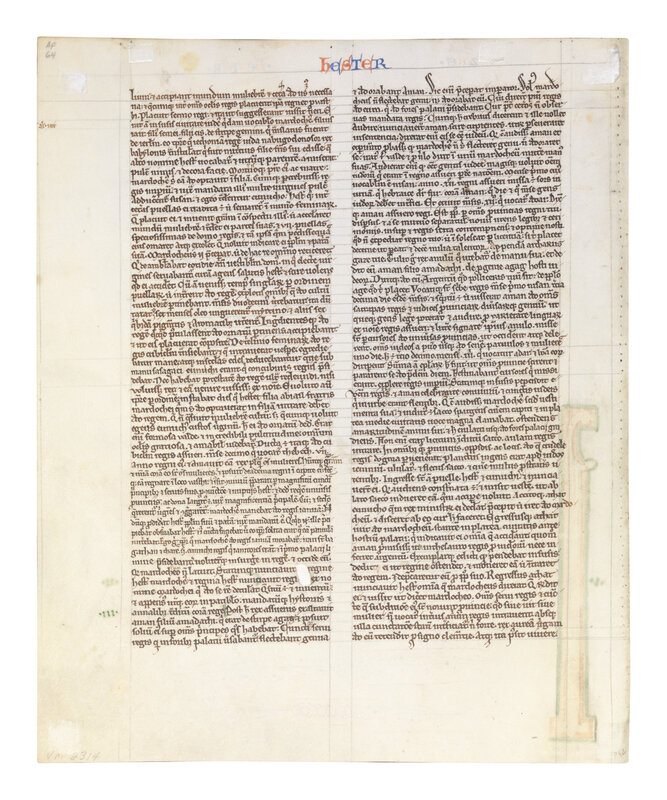Condition Report
Contact Information
Lot 9
ANONYMOUS ENGLISH ILLUMINATOR
A leaf from a Bible, with an inhabited initial ‘I’, in Latin, illuminated manuscript on parchment [England, c. 1225-1250]
A leaf from a Bible, with an inhabited initial ‘I’, in Latin, illuminated manuscript on parchment [England, c. 1225-1250]
Sale 2033 - Western Manuscripts and Miniatures
Jun 27, 2024
10:00AM CT
Live / Chicago
Own a similar item?
Estimate
$1,500 -
2,000
Price Realized
$1,778
Sold prices are inclusive of Buyer’s Premium
Lot Description
ANONYMOUS ENGLISH ILLUMINATOR
A leaf from a Bible, with an inhabited initial ‘I’, in Latin, illuminated manuscript on parchment [England, c. 1225-1250]
A leaf from a Bible, with an inhabited initial ‘I’, in Latin, illuminated manuscript on parchment [England, c. 1225-1250]
A fascinating English Bible leaf, with a gold initial inhabited with a quadruped and an early case of penwork decoration in the shape of a monster.
c. 255 x 205 mm. Single leaf, modern foliation “103” in pencil in the lower left corner of recto, ruled in plummet for two columns of 58 lines (written space: c. 195 x 150 mm), with an extra rule in the top margin for the running titles, vertical and horizontal bounding lines ruled full across, prickling for rules in the inner margin, written above top line in two sizes in brown ink in a formal gothic book hand, rubrics in red, running titles and chapter numbers alternately in red and blue, only one chapter number originally supplied by the scribe, with the modern chapter numbers added in the margins in green ink in a contemporaneous (perhaps slightly later) hand, ONE LARGE TWENTY-FOUR-LINE ILLUMINATED INITIAL in light brown with white tracery, enclosed by foliating designs in blue with white, light brown, and orange highlights, on burnished gold ground outlined in green, set in the inner margin and extending into the lower margin with spontaneous bas-de-page penwork decorations in blue and red of a monster spitting fire from its mouth? (slight soiling and stains on the parchment, a small paste-on parchment repair, tape stains on the four corners of the verso, a minor tear on the upper edge, initial slightly flaked and rubbed, else in excellent condition).
This leaf comes from a thirteenth-century English Bible likely made for monastic use, and it bears many fascinatingly unusual textual and iconographic features. The leaf contains the end of Nehemiah and the beginning of Esther, reading on the recto from Nehemiah 13:6, “… ad regem, et in fine dierum rogavi regem,” to Esther 4:11 on the verso, “…atque ita possit vivere.” The beginning of Esther is introduced with an illuminated initial ‘I’, for “In,” set on burnished gold ground with the letter’s stem enclosed by foliating designs.
Although it is often difficult to distinguish English from French Bibles of the thirteenth century, the parent manuscript of the present leaf displays salient traits of an English origin, such as the order of the books, the chapter divisions, the inclusion of the apocryphal Epistle to the Laodiceans, various textual readings, the ten-part division of the Psalms and the inclusion of the Gallicanum, Hebraicum, and Romanum versions. The illustration of the 101st Psalm with the Poor Man Praying to God, and the style of decoration point to southern England.
Peter Kidd has observed the dating complexities, as the evidence of the present leaf and its parent manuscript points in divergent directions. Codicological features, such as the pricking in the inner margin and the writing “above top line,” are typically early thirteenth-century and suggest a date no later than c. 1240, and textual features (such as the absence of the modern chapter divisions, and the pre-Paris order of the books) support such an early dating. The penwork decoration that occupies the recto lower margin of the present leaf, however, suggests a date probably not earlier than the 1230s, and more typical of the 1240s and 1250s: such penwork seems to have appeared first in England in Oxford, probably influenced by Italian manuscripts brought by students from another university town, Bologna.
The combination of features typical of both the first and second quarters of the thirteenth century suggests that the book was made perhaps in the 1230s in a provincial center or by a team, perhaps in a monastery, who were not fully up to date with developments that had taken place in centers such as Oxford. Features such as the iconography of Psalm 101 are very unusual, and as more illuminated leaves are identified in future, it may become possible to date and localize the production more closely.
Provenance
(1) Bruce P. Ferrini (1949-2010), Akron, OH;
(2) Sam Fogg, London, acquired in September 1996 by:
(3) Robert McCarthy, London, MS BM 1058c.
Parent manuscript
The parent volume has been extensively described in de Ricci 1937, Hatch 1958, and in the catalogue of Christie’s New York, 1 October 1980. The latter provides the most detailed physical description, counting 352 leaves with 29 historiated initials on gold grounds, 60 illuminated initials, and three pages of canon tables set within painted columns and arches. Hatch 1958 records the sequence of texts: the books of the Bible (ff. 1–275), Eusebian canon tables (ff. 275v–276) and a concordance (ff. 277–352).
1. Written and illuminated in England; perhaps for use in a monastic environment, to judge by the three parallel versions of the Psalms and the later provenance;
2. In an English monastic library before the Reformation;
3. Rebound in England in the sixteenth or early seventeenth century;
4. Joseph Alberto Martini (1870–1944), book-dealer and collector of New York, acquired in 1914 by:
5. General Theological Seminary, New York, their sale at:
6. Christie’s New York, 1 October 1980, lot 145, bought by a US dealer (Bruce P. Ferrini?) and subsequently broken up.
Sister leaves
The Schøyen Collection, London and Oslo (MS 1278) has reunited 209 leaves from various sources. There are another eight leaves in Ohio State University (CMS.113.II-13), one more in Ball State University, David Owsley Museum of Art, 1984.26.1. A further two are in the McCarthy collection, published together with the present leaf in his catalogue as no. 9 (see below).
LITERATURE
On the present leaves as well as their parent manuscript and sister leaves, published: S. de Ricci and W. J. Wilson, Census of Medieval and Renaissance Manuscripts in the United States and Canada, II, New York, 1937, repr. 1961, p. 1285, no. 7; W.H.P. Hatch, ‘Some Manuscripts in the Seminary Library: A Latin Manuscript of the Bible’, Bulletin of the General Theological Seminary, 44 (1958), pp. 31–36; Christie’s New York, 1 October 1980 (sale 5002), lot. 145; C. de Hamel, Cutting Up Manuscripts for Pleasure and Profit: The 1995 Sol. M. Malkin Lecture in Bibliography, Charlottesville, 1996, pp. 19–20; C. de Hamel, ‘The Life of Saint Martin’, Papyri Graecae Schøyen (PSchøyen II): Essays and Texts in Honour of Martin Schøyen, Papyrologica Florentina, 40, Florence, 2010, pp. 117–22; Peter Kidd, The McCarthy Collection, Vol. II, Spanish, English, Flemish and Central European Miniatures, London, 2018, no. 9, pp. 50-3 (with further literature).
We are grateful to Peter Kidd for permission to quote from his catalogue for this entry. Freeman’s | Hindman thank Senior Consultant Sandra Hindman and Elliott Adam for their assistance in preparing this sale.
The Collection of Robert McCarthy



